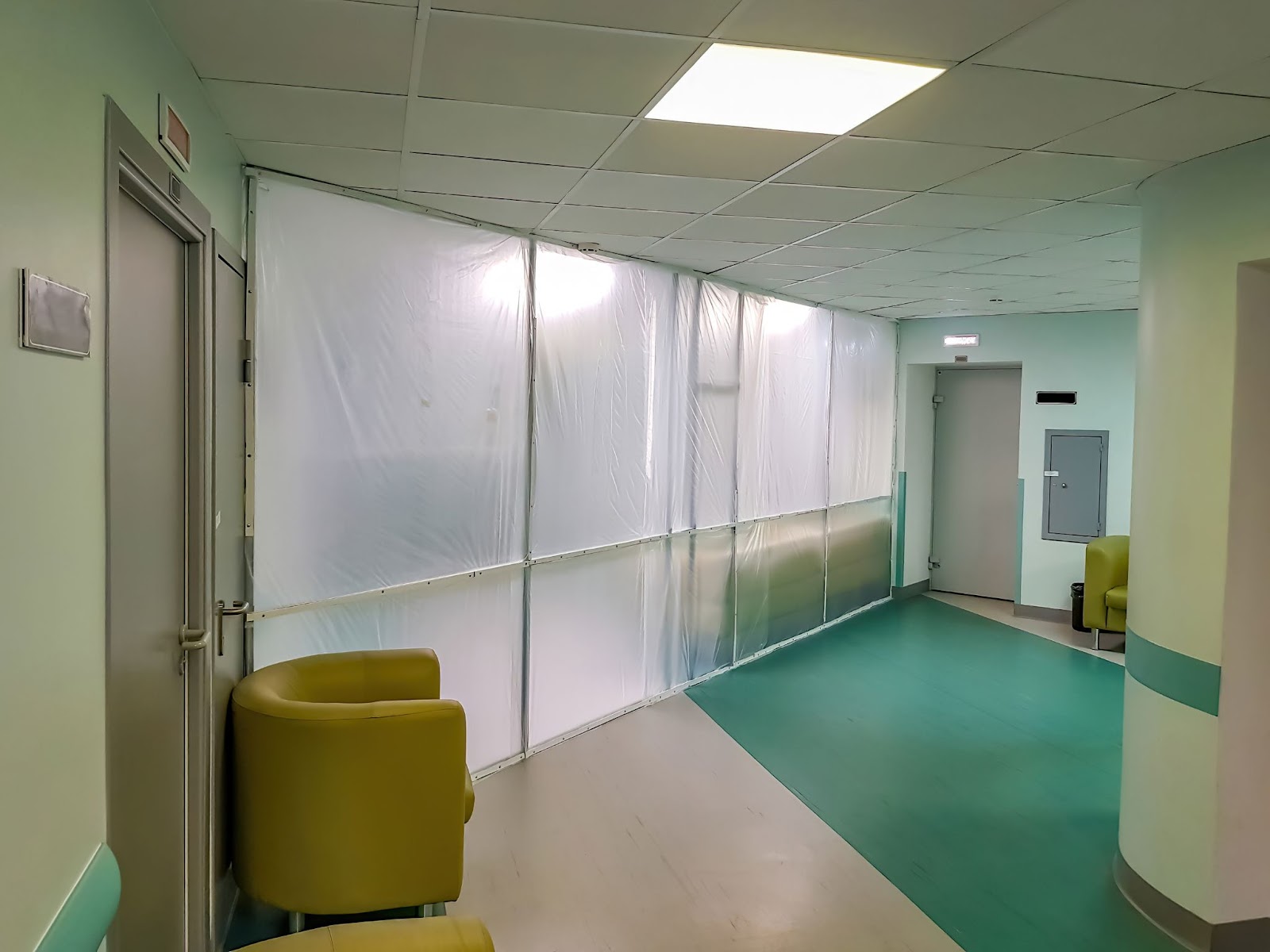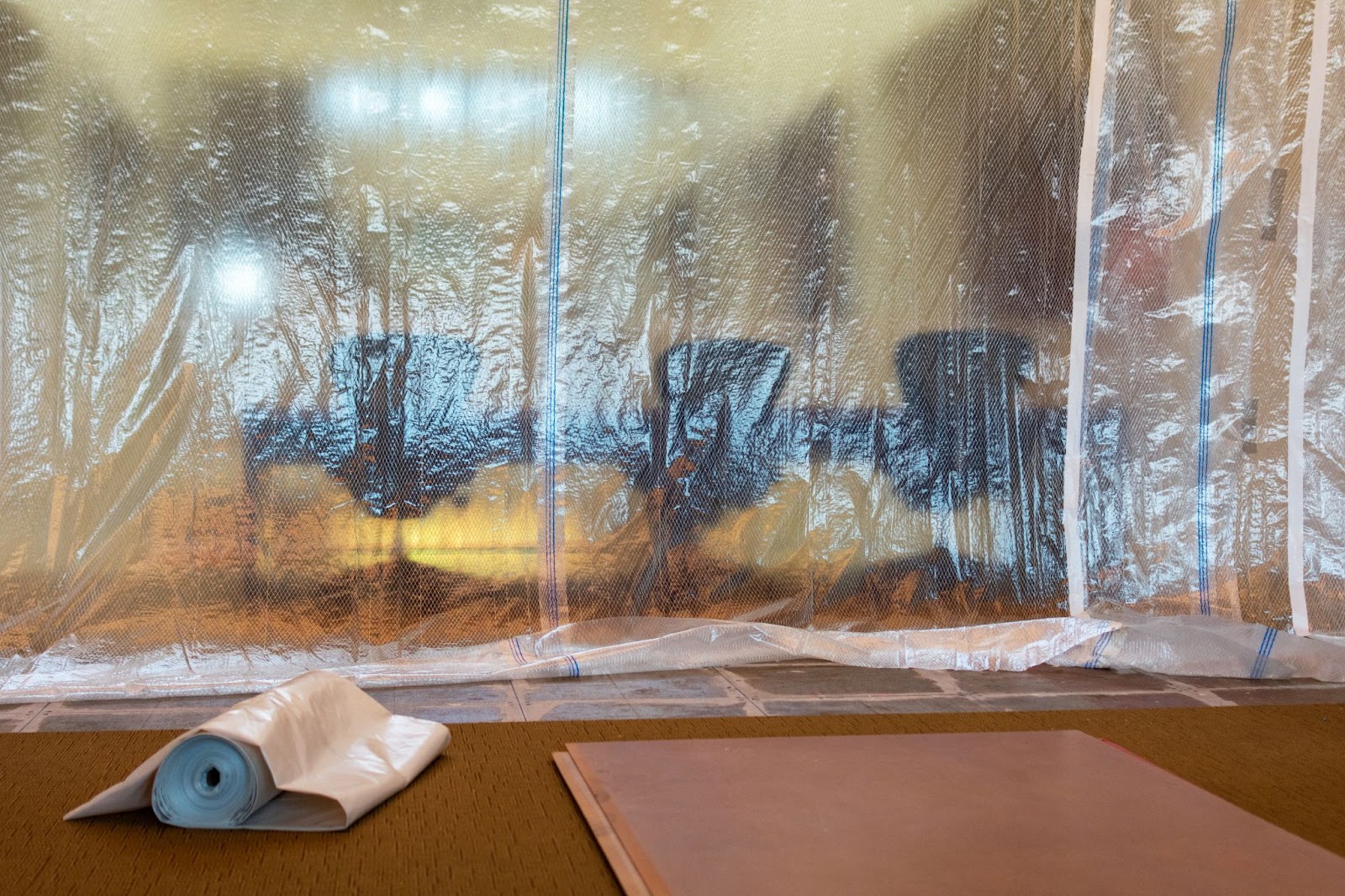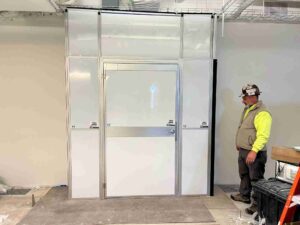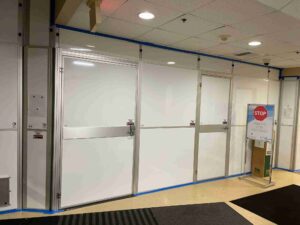ZipWall Dust Barrier System: A Comprehensive Guide

No matter how tidy you keep your job sites, construction and renovation projects — both large and small — can create big messes. And for the sake of keeping people safe and clients happy, it’s important to keep these messes contained. That’s where dust containment solutions such as ZipWall come in.
ZipWall is a reusable containment system that creates barriers using plastic sheets and zippers. It’s also one of the most popular products on the market for containing dust and debris during construction projects.
But that doesn’t necessarily mean it’s the best one — or that it’s right for every job. Keep reading to learn more about the ZipWall dust barrier system and how it measures up as a temporary wall solution.
What Is ZipWall?
ZipWall is a reusable containment system for securing plastic barrier sheets using telescoping poles in lieu of tape and ladders.
The ZipWall system comes with 12 lightweight, spring-loaded poles that can telescope as high as 12 feet and lock into place by twisting. (ZipWall also offers a 20-foot anodized aluminum pole for ultra-high ceilings.)
The kit also comes with zipper enclosures and a carry bag, making the system portable. Plastic sheets aren’t included and can be purchased from ZipWall or other manufacturers.
ZipWall is a welcome alternative to taping plastic sheets to ceilings, as it allows for fast and easy sealing without the risk of damage to surfaces. At the same time, its plastic barriers are thin and flimsy. This makes ZipWall less durable than other systems, with no soundproofing or true privacy.
Types of ZipWall Products
In addition to the classic ZipWall system described above, ZipWall offers its own dust barriers and other products including:
Zipwall Dust Barriers
ZipWall poles can be paired with any standard plastic sheeting ranging from 1–10 mil in thickness. The company recommends 2–10 mil plastic sheeting on a continuous roll for easier application.
ZipWall offers two main categories of dust barrier sheets:
- Plastic sheeting: This barrier is 3 mil thick and white in color rather than transparent, in order to provide privacy.
- Nylon fabric sheets: A “greener” alternative to plastic sheeting, this barrier is machine washable and designed to be reused.
ZipDoor Kits
Door kits are available for jobs that only require a doorway to be sealed off. The barrier, which is preinstalled with zippers, is attached using two-sided tape. Door kits are sold for residential or commercial zones and range in price depending on size.
Magnetic Barriers
While ZipWall may be famous for its zippers, the company recently released an alternative dust barrier system that closes using magnetic strips for hands-free access.
How It Works: How to Use and Install ZipWalls
Here are the basic steps for installing the standard ZipWall dust barrier system:
- Attach the head piece to the pole. The rectangular head comes with a non-skid plate attached. Remove the plate to use the head piece for installation.
- Attach the sheet to the head. Place the edge of the sheet between the two pieces of the head that you’ve just separated (the head and the plate). Then, with the sheet between them, reconnect the two pieces, using the keyholes to lock them in place.
- Unlock the pole to extend it. You can unlock the pole by twisting the inner pole counter-clockwise and then extending the pole upward until the head, with the sheet, touches the ceiling.
- Prop up the pole. Make sure the foot of the pole is squarely on the floor as you secure the head flat against the ceiling, then lock it in place by turning the pole clockwise. There should be enough tension between the head and foot to ensure the pole stands up on its own. Adjust and tighten the pole as needed.
- Add a second pole, with the same sheet attached. Make sure the sheet doesn’t sag between the poles — it should be pulled taut. Adjust the poles and sheet as needed for a tight fit.
- Secure the sheet at the base. For true containment, the sheet will also need to be sealed against the floor. To do this, lift the foot of the pole to tuck the sheet underneath.
Is ZipWall Sustainable?
For facilities managers and contractors who are looking for sustainable dust containment solutions, the ZipWall system is relatively environmentally friendly. The poles and zippers are meant to be reused. However, when paired with one-use plastic sheeting, the system comes up short.
Recently, the company released a nylon fabric sheet, which can be washed and reused. This makes the system greener for project managers who have the time and resources to care for the fabric barrier.
However, the fabric sheeting was only released in October 2022, which means customer reviews have yet to reveal the long-term durability of the product. In order to maintain a clean, aesthetic appearance, contractors may need to replace the white fabric regularly due to staining.
ZipWall Pricing
A complete ZipWall Dust Barrier Toolkit costs $1,285.60. Purchased as a bundle, the system is 16 percent less compared to buying each of the parts separately. While drywall may seem more affordable (depending on the size of the job), the ZipWall system is reusable. On the other hand, a temporary drywall needs to be built for every project.
Additionally, both drywall and ZipWall require installation and breakdown labor. This differentiates them from rentable dust containment systems, such as the ones offered by Temporary Wall Systems, which include setup and removal in the cost.

ZipWall Pros and Cons
Like other temporary wall systems, ZipWall has its advantages and disadvantages. It’s important to weigh the following when determining whether it’s the right fit for your project.
Pros
- Familiarity: Many contractors have become familiar with ZipWall or similar products, since it’s a popular option for sealing off work sites. It’s also easily accessible, with multiple distributors selling it online.
- Convenience: The ZipWall system was originally designed to replace the practice of taping plastic from floor to ceiling. This was not only time- and labor-intensive but also potentially ineffective, as plastic sheets are prone to falling down when attached by tape alone. In this respect, Zipwall is a relatively fast and easy alternative.
- Sustainability: As stated above, ZipWall kits can be used a number of times. This makes it a sustainable option when used with reusable nylon plastic instead of standard disposable plastic sheets.
- Pricing: The ZipWall dust barrier system is relatively inexpensive compared to alternative temporary containment walls. However, it costs more than conventional plastic sheeting and tape.
Cons
- Soundproofing: ZipWall Dust Barriers, both plastic as well as nylon fabric sheeting, offer zero noise reduction. This can negatively impact occupant satisfaction during construction and renovation projects.
- Privacy: Although ZipWall moved away from its completely transparent plastic sheets, contractors may pair the system with transparent plastic sheeting. This means occupants can easily see what’s happening on the other side. The lack of sound absorption also limits privacy.
- Containment: While ZipWalls are generally effective at keeping dust contained, they’re not perfect. If improperly installed, sheeting between poles may sag, releasing dust particles.
- Effort: While the ZipWall system allows users to seal off work sites faster than the taping method, the poles and reusable dust barriers will need to be thoroughly cleaned after every job.
- Range of Application: Due to its poor sound absorption and privacy, the ZipWall system is unsuitable for many environments. This includes healthcare, retail, hospitality, offices, and other commercial spaces that need to stay open for business during renovation projects. Commercial contractors would be well advised to pursue a more reliable and soundproof containment wall system.
ZipWall Alternatives
ZipWall is one of the most well-known options for managing dust and debris during construction and renovation projects, but it’s far from the only solution out there. Below are some other options contractors and facilities managers may want to explore.
Drywall
Drywall barriers are a classic containment strategy, especially for long-term projects. They offer effective dust containment, noise reduction, and the potential for a highly finished look. However, compared to other systems, they’re the most time-consuming and labor-intensive.
Drywall barriers can only be used once per project, then they need to be demolished and disposed of, producing high amounts of dust and debris. Speaking of disposal, when drywall ends up in landfills, it leaches toxic chemicals into groundwater and releases poisonous hydrogen sulfide gas. Given its negative impact on the environment, drywall is considered to be one of the least sustainable containment options.
Magnetic Dust Barriers
3rd Hand’s Magnetic Dust Barriers offer a hands-free option. This product allows you to suspend plastic sheets via poles, much like ZipWall, but instead of sealing openings by zipper, they’re sealed by magnetic “snap” closures. You can walk through these hands free, and they automatically seal behind you.
Kits start around $278, making it less expensive than a ZipWall kit. As mentioned above, ZipWall now offers magnetic closures for $269; poles and sheets are sold separately.
Modular Wall Systems
Modular wall systems consist of sturdy wall panels that are pressure fitted together into an airtight containment wall. Products range in quality based on materials, adjustability, safety ratings, noise reduction, aesthetics, and installation.
Costs vary based on the quality of materials used — from polycarbonate panels with a foam core to reinforced fiberglass, aluminum, and galvanized steel. The highest-rated systems:
- Produce virtually no dust, meeting ICRA (infection control risk assessment) guidelines in healthcare facilities
- Can reduce sound by as much as 50 percent
- Result in less waste compared to other modular wall solutions
Modular walls may be less affordable and require a couple of hours to erect and disassemble. However, many contractors opt to rent modular barrier systems through a full service rental company to save on costs and labor.
Choosing a Temporary Wall Solution
While ZipWalls offer some benefits, they’re not necessarily the right dust containment system for every project, especially in the commercial construction space.
At Temporary Wall Systems, we’re dedicated to providing containment solutions that are safe, clean, and environmentally responsible, but still durable enough for rigorous day-to-day operations. We understand firsthand the needs and challenges of an active construction or renovation site, which is why we offer the highest quality walls on the market. TWS makes things easy for you and your team every step of the way.
From installation to removal for projects big or small, our experts deliver full-service rentals that meet your unique needs and project goals: Rented. Delivered. Installed. Removed. Contact us for an estimate today.


